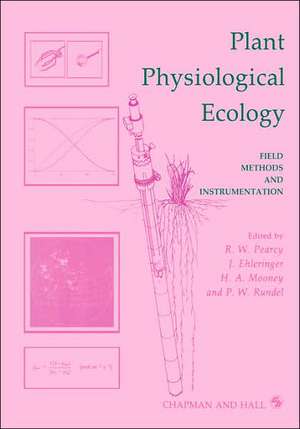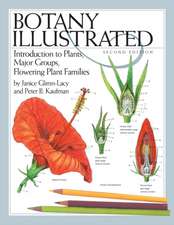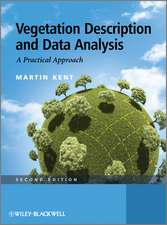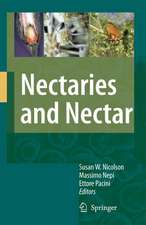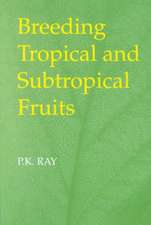Plant Physiological Ecology: Field methods and instrumentation
Editat de R. Pearcey, H.A. Mooney, P.W. Rundelen Limba Engleză Hardback – mai 1989
| Toate formatele și edițiile | Preț | Express |
|---|---|---|
| Paperback (1) | 1231.01 lei 6-8 săpt. | |
| SPRINGER NETHERLANDS – 26 sep 2011 | 1231.01 lei 6-8 săpt. | |
| Hardback (1) | 1237.80 lei 6-8 săpt. | |
| SPRINGER NETHERLANDS – mai 1989 | 1237.80 lei 6-8 săpt. |
Preț: 1237.80 lei
Preț vechi: 1509.51 lei
-18% Nou
Puncte Express: 1857
Preț estimativ în valută:
236.84€ • 247.31$ • 195.58£
236.84€ • 247.31$ • 195.58£
Carte tipărită la comandă
Livrare economică 15-29 aprilie
Preluare comenzi: 021 569.72.76
Specificații
ISBN-13: 9780412232305
ISBN-10: 0412232308
Pagini: 458
Ilustrații: XX, 458 p.
Dimensiuni: 178 x 254 x 34 mm
Greutate: 1.02 kg
Ediția:1989
Editura: SPRINGER NETHERLANDS
Colecția Springer
Locul publicării:Dordrecht, Netherlands
ISBN-10: 0412232308
Pagini: 458
Ilustrații: XX, 458 p.
Dimensiuni: 178 x 254 x 34 mm
Greutate: 1.02 kg
Ediția:1989
Editura: SPRINGER NETHERLANDS
Colecția Springer
Locul publicării:Dordrecht, Netherlands
Public țintă
ResearchCuprins
1 Principles of instrumentation for physiological ecology.- 1.1 Introduction.- 1.2 Measurement and measurement errors.- 1.3 Instrument organization.- 1.4 Instrument initiation.- 1.5 Postscript.- 2 Field data acquisition.- 2.1 Introduction.- 2.2 Analog recorders.- 2.3 Digital recorders.- 2.4 Integrators.- 2.5 Sampling considerations.- 3 Water in the environment.- 3.1 Soil moisture.- 3.2 Atmospheric moisture.- 3.3 Moisture flux.- 4 Measurement of wind speed near vegetation.- 4.1 Introduction.- 4.2 Flow in wind tunnels, growth cabinets and ducts.- 4.3 Weather stations and field survey.- 4.4 Wind profiles above vegetation.- 4.5 Boundary layer resistance.- 4.6 Calibration.- 4.7 Aerodynamic influence by masts.- 4.8 Visualization.- 4.9 Pressure measurements.- 4.10 Some applications.- 5 Soil nutrient availability.- 5.1 Introduction.- 5.2 Difficulties in measuring nutrient availability.- 5.3 Nitrogen availability.- 5.4 Phosphorus availability.- 5.5 Sulfur availability.- 5.6 Availability of essential cations.- 5.7 Micronutrient availability.- 5.8 Soil classification.- 5.9 Bioassay of nutrient availability.- 5.10 Soil acidity.- 5.11 Soil salinity.- 5.12 Soil redox potential.- 5.13 Comments on sampling.- 5.14 Index units.- 6 Radiation and light measurements.- 6.1 Introduction.- 6.2 Definitions and units.- 6.3 Energy versus photons as a measure of PAR.- 6.4 Radiation sensors: general characteristics.- 6.5 Determination of the diffuse and direct components of radiation.- 6.6 Calibration of radiation sensors.- 6.7 Sampling considerations.- 6.8 Photographic estimations of light climate.- 6.9 Spectral radiometry.- 7 Temperature and energy budgets.- 7.1 Introduction.- 7.2 Energy budget approach.- 7.3 Variations in air and leaf temperatures with height.- 7.4 Temperature and its measurement.- 7.5 Orientation and its measurement.- 7.6 Calculation of incident solar radiation on different surfaces.- 7.7 Leaf absorptance and its measurement.- 7.8 Boundary layer considerations.- 8 Measurement of transpiration and leaf conductance.- 8.1 Introduction.- 8.2 Leaf transpiration rate.- 8.3 Leaf conductance to water vapor.- 8.4 Instrumentation for transpiration measurements.- 8.5 Calibration of water vapor sensors.- 8.6 Systems for measuring transpiration and leaf conductance.- 8.7 Whole-plant measurements of transpiration.- 9 Plant water status, hydraulic resistance and capacitance.- 9.1 Introduction.- 9.2 Water potential and its components.- 9.3 Water content.- 9.4 Hydraulic resistance and capacitance.- 9.5 Conclusion.- 10 Approaches to studying nutrient uptake, use and loss in plants.- 10.1 Introduction.- 10.2 Nutrient uptake.- 10.3 Nutrient use and nutrient status.- 10.4 Chemical analysis.- 10.5 Nutrient loss.- 11 Photosynthesis: principles and field techniques.- 11.1 The system concept.- 11.2 Principles of photosynthesis measurement.- 11.3 Components of gas-exchange systems.- 11.4 Real photosynthesis systems.- 11.5 Matching instrument to objective.- 11.6 Calibrating photosynthesis systems.- 11.7 Calculating gas-exchange parameters.- 11.8 List of symbols.- 12 Crassulacean acid metabolism.- 12.1 Introduction.- 12.2 Measurement of succulence.- 12.3 Nocturnal acidification.- 12.4 Nocturnal CO2 fixation.- 12.5 Analysis of day—night and seasonal patterns of CO2 and H2O vapor exchange.- 12.6 Measurement of photosynthesis and respiration by O2 exchange.- 12.7 Water relations.- 12.8 Stress physiology.- 13 Stable isotopes.- 13.1 Introduction.- 13.2 Natural abundances of stable isotopes of ecological interest.- 13.3 Stable isotope mass spectrometry.- 13.4 Samplepreparation.- 13.5 Sample variability.- 13.6 Application of stable isotopes in ecological studies.- 14 Canopy structure.- 14.1 Introduction.- 14.2 Direct methods.- 14.3 Semidirect methods.- 14.4 Indirect methods.- 14.5 Summary.- 15 Growth, carbon allocation and cost of plant tissues.- 15.1 Introduction.- 15.2 Growth analysis.- 15.3 Fate of carbon.- 15.4 Carbon and energy costs of growth and maintenance.- 16 Root systems.- 16.1 Introduction.- 16.2 Assessing root system structure and biomass in the field — determining what is there.- 16.3 Determination of root length and surface area.- 16.4 Microscale distributions of roots.- 16.5 Root system turnover and production.- 16.6 Root phenology and growth.- 16.7 Root system function.- 16.8 Root associations.- 16.9 Concluding thoughts.- 17 Field methods used for air pollution research with plants.- 17.1 Introduction.- 17.2 Studies of air pollution absorption.- 17.3 Air pollution instrumentation.- 17.4 Cuvettes.- 17.5 Field fumigation systems and approaches.- 17.6 Summary.
